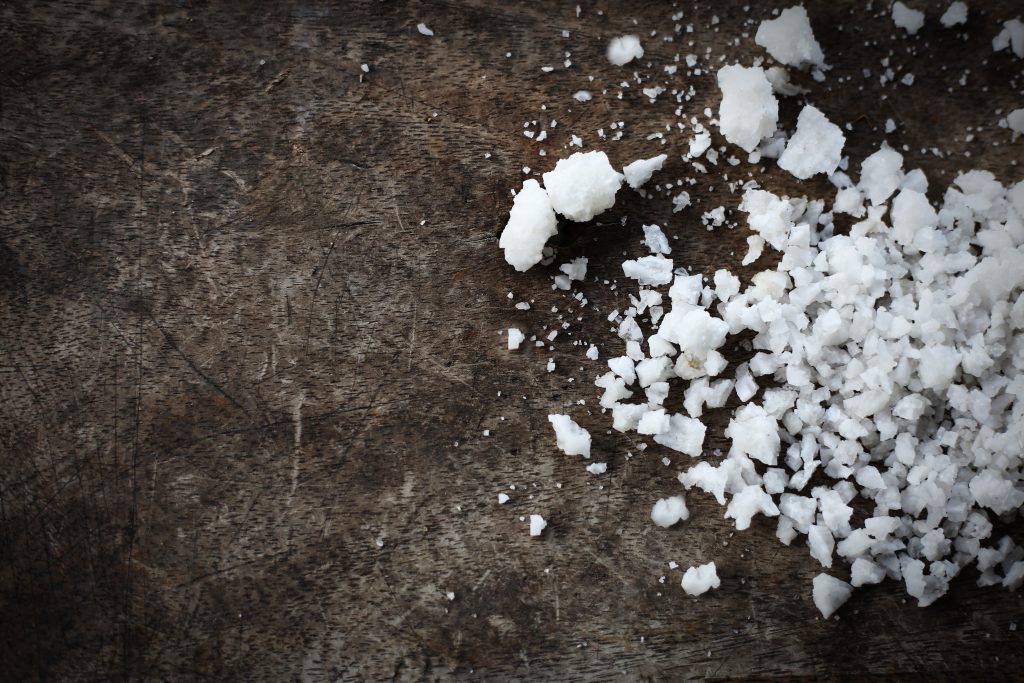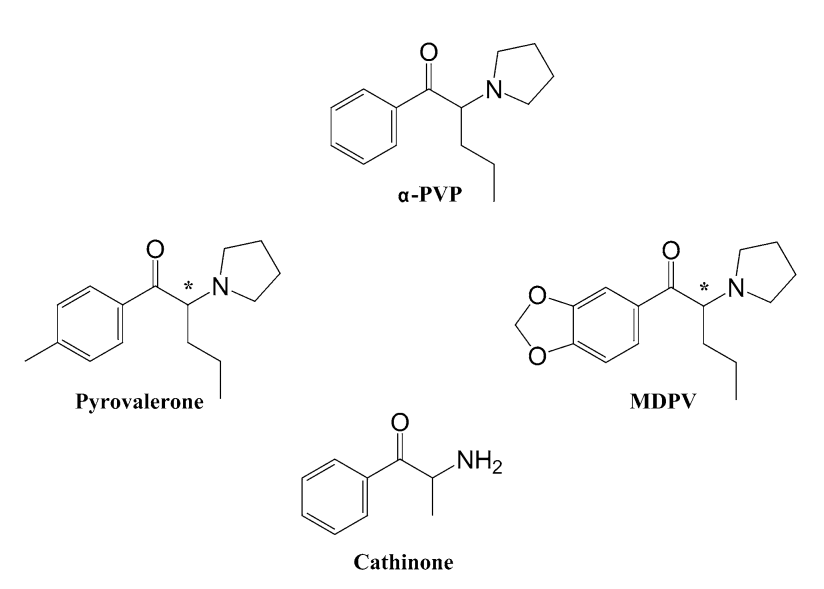In 1963, a chemical compound called A-PVP was patented by the German pharmaceutical company, Boehringer Ingelheim.
For decades the drug went ignored — nobody knew about it.
We now know this drug under the name of flakka, after it caused a devastating epidemic in the United States in 2015.
After reaching the shores of Florida in 2014, flakka use immediately started to grow out of control.
The drug causes severe psychotic episodes — people strip naked, roll around, and scream uncontrollably. It often results in savage outbursts of violence and personal harm sparked by paranoia and hallucinations.
Flakka is in the same class as the synthetic compounds known commonly as “bath salts.”
The problem is starting to get out of hand as more and more people are looking for the “cheap” high it produces.

What is Flakka?
Flakka is the common name for A-PVP (alpha-pyrrolidinopentiophenone hydrochloride). The name flakka comes from the Spanish term “la flaca” — meaning “skinny girl.”
It’s a man-made version of the naturally occurring alkaloid class found in the East-African khat plant (Catha edulis) [6]. There are dozens of compounds in this class, most of which are made in salt forms — giving them a similar appearance to common bath salts (hence the name).

Flakka works by changing neurotransmitter levels in the brain — causing extreme hyperstimulation, hallucinations, and uncontrollable emotional outbursts.
Users lose their ability to tell the difference between what’s real and what’s not.
Even automatic processes such as body temperature or blood pressure go out of control, often resulting in death without immediate medical attention.
At the height of the last flakka epidemic, from September 2014 to December 2015, roughly 400 cases of flakka intoxication and 60 deaths were reported in South Florida alone [9].
People often compare the effects to a combination of crack cocaine and crystal meth.
Doctors are calling the main effect of the drug “excited delirium.” People become agitated and have bursts of incoherent babbling, screaming, and loss of body control — often accompanied by violent outbursts like ramming their head into glass windows or punching brick walls until their hands break.
There’s no shortage of bizarre flakka outburst stories floating around the internet.
Why Do People Take Flakka?
It may seem strange that people are taking flakka when there are so many horrible side-effects.
Here Are 4 Main Reasons Why Someone Might Take Flakka:
1. They’re Looking for a Cheap High
The main reason one might take a hit of flakka is to feed an addiction to stimulants, especially when the user doesn’t have enough money for crack or crystal meth.
The drug is potent and incredibly cheap — one hit is just $3–$5 on the street.
Flakka costs a fraction of the price of crack, which is about $10–20 for the average dose and crystal meth at $10–$15. People are referring to the drug as “$5 Insanity” because a single $5 hit of flakka delivers the same kick as roughly $80 worth of cocaine — It makes people go crazy.

2. They Don’t Understand How Dangerous It Is
Many people who were arrested or rescued after a hit of flakka have spoken out about their motives after the fact. Many users admit they took the drug to feel high but weren’t aware of the adverse side- effects.
Users wanted to feel euphoric and energized — not psychotic and aggressive.
Public awareness about flakka is weak, likely because of the recent introduction of the drug on to American soil.
3. It’s Sold Under the Names of Other (More Expensive) Drugs
In 2015, Florida police captured a naked 17-year old girl high on flakka with severe lacerations to her face and body after jumping through a window. She allegedly jumped through the glass window, gathered herself, then jumped back out — obtaining serious injuries with both attempts. She then attacked a stranger on the front lawn and ran away screaming “I am God! I am Satan!”.
She later reported that she thought she’d taken LSD.
4. It’s Easy to Find
One of the main reasons why this drug is becoming so prevalent is that it’s so easy to obtain from the internet.
It’s sold online under the label “bath salts” or “fertilizer” due to the similar appearance of the crystals to these daily household items.
The packages often come in the mail with the label “not for human consumption.”
Even with agencies such as the FBI stepping in to investigate these websites, the problem persists. As soon as one website goes down, another one takes its place.
Common Names for Flakka Online Include:
- Gravel
- Bath salts
- Bonsai fertilizer
- Plant food
- Insect repellent
- Research chemicals
- Jewelry cleaner
How are People Taking Flakka?
Flakka is chemically a very stable compound — which means it can be heated, dissolved, or smoked without losing its chemical shape.
This makes flakka a versatile substance in terms of administration.
People Are Taking Flakka in a Number of Different Ways Including:
- Snorting
- Eating
- Smoking
- Vaping
- Injecting
This versatility resulted in an increase in users because it allows people to take it however they normally take their drugs. It’s also a popular compound drug dealers use to ‘cut’ drugs as to increase profits. Flakka is cheaper than almost all other drugs — so adding it to the mix provides a strong high, but costs the dealer a lot less.
Here are some examples of how dealers are using flakka to increase their profits:
- It can be snorted, so dealers are adding cutting cocaine with it.
- It can be injected, so dealers are cutting crystal meth with it.
- It can be smoked, so people are cutting crack and K2 (spice) with it.

What are the Effects of Flakka?
Flakka primarily affects two neurotransmitters in the brain — norepinephrine (part of the fight or flight response) and dopamine (one of the main neuroregulatory molecules in the brain).
It causes rapid firing of these neurotransmitters, forcing the brain into a state of hyperexcitability.
These effects are very similar to other stimulant drugs such as crack and crystal meth.
All of these drugs cause the user to become excited and often causes outbursts of aggression or mania — but nothing quite like flakka.
One of the main side-effects of flakka is high body temperature, often prompting users to strip naked and run around the street like a maniac, shouting in anger or quivering in fear. The psychosis-induced stripping of flakka users is so common it’s become a signature sign of the drug’s influence.
Another common effect is that it makes people feel like they have super-human strength. They feel invincible and are often seen climbing buildings, trying to hop barbed-wire fences, and attacking trucks or cars.
Side Effects of Flakka
- Appetite suppression
- Dehydration
- Dry mouth
- Excessive sweating
- Excited delirium
- Hallucinations
- High body temperature
- Muscle spasms
- Paranoia (often severe)
- Seizures
- Sudden death
- Suicidal thoughts
- Tactile enhancement
- Teeth clenching
- Violent outbursts
- Vision disturbances
Some of these side-effects are temporary while the drug is in effect — others are permanent.
Potential (Permanent) Side-Effects of Flakka
- Abnormal heartbeats
- Addiction
- Brain damage
- Chronic insomnia
- High blood pressure
- Kidney damage
- Liver failure
- Post-traumatic stress disorder
- Severe anxiety
It can also cause people to have difficulty with their vision and become hypersensitive to sunlight. Some ex-flakka users say they can no longer be out in the sun without receiving severe sunburns and heat exhaustion.
Many flakka users report extreme and frequent anxiety attacks following an incident — yet will take the drug again because of it’s incredibly addictive nature.

How Bad is the Flakka Problem?
The flakka problem is gradually increasing in the United States since it was first introduced to Florida in 2014.
Despite flakka’s inclusion as a schedule I controlled substance in 2016, the drug remains easy to obtain.
The root of the problem was a prominent Chinese manufacturing company known as Kaikai Technology Co. — owned by the prominent drug lord, Bo Peng. They manufactured and sold flakka online to the United States for as low as $1500 per kilogram (roughly $50,000 worth on the streets of Florida).
The worst part?
It was perfectly legal to do this until just recently.
In 2015, the United States government worked in conjunction with Chinese officials to crack down on flakka production in China. This lead to about 150 arrests in relation to the distribution network, including a Canadian father and son pair who were buying large quantities of the drug from China to distribute across the United States.
This put a major dent in the flakka distribution network in the United States — but flakka appears to be making a comeback.
Outside of the United States, flakka is on a steady rise. The epicenter of the problem appears to be Brazil at the moment. From here, the problem spreads up through Central America, Mexico, and back to the United States.
It appears the timely intervention of the United States government bought local police forces some time — causing what police officers are calling a “flakka drought” in Florida.
Now, case reports are popping up all over the country with criminals testing positive for flakka in their system and people ending up in hospitals after signature “psychotic naked flakka episodes.”
How Does Flakka Work?
Flakka is a potent inhibitor of the dopamine and norepinephrine transporters but has little to no effect on serotonin [1].
It doesn’t cause the release of these neurotransmitters, rather it blocks their reuptake, causing their levels to build uncontrollably outside of the neurons. The result is severe hyperstimulation and excitability in the brain.
1. Flakka Increases Dopamine Concentrations
Dopamine is critically involved with a number of processes in the human brain, including the reward center. This is the region of the brain tasked with controlling our urges and instincts with a surge of oxytocin — making us feel euphoric for a brief moment. It makes the body want to repeat whatever activity caused the release of dopamine and oxytocin. This system rewarded us for behaviors that sustained life such as eating, mating, or escaping from danger.
In the case of flakka, this system is hijacked and driven out of control. It makes us behave like animals, constantly seeking further stimulation of this system by doing bizarre and reckless things like attacking people or bashing our heads onto hard surfaces.
2. Flakka Increases Norepinephrine Concentrations
Norepinephrine is our natural “fight or flight” hormone.
It’s the primary neurotransmitter that makes us feel alert and awake and causes us to feel hypervigilant in a stressful situation — such as coming face to face with a bear.
It causes our heart rate to increase, our airway to open up, and our blood pressure to increase. Our body changes balance quickly to give us the best chances possible for fighting off the danger or running away to safety.
On flakka, norepinephrine levels skyrocket. The body enters a state of extreme stimulation. This is what makes people feel intense heat, heart palpitations, and high blood pressure. It’s also why people on flakka tend to feel like they have superhuman strength.
The Potency of Various Stimulant Drugs on Dopamine, Norepinephrine, & Serotonin [3].
| Compound | Dopamine | Norepinephrine | Serotonin |
| Flakka | ↑↑↑↑ | ↑↑↑↑ | ↑ |
| MDPV (Bath salts) | ↑↑↑ | ↑↑↑ | ↑↑ |
| Cocaine | ↑ | ↑ | ↑↑↑↑ |
| Amphetamine | ↑↑ | ↑↑ | ↑↑↑ |
Can Flakka Cause an Overdose?
Yes.
It’s very easy to overdose on flakka because of how potent it is.
People often take flakka at the same dose as their usual drugs, like cocaine or methamphetamine — only to end up overdosing.
Flakka is roughly 10 times as potent than cocaine, and 5 times as potent as methamphetamines. It’s even twice as potent as the more common bath salt — MDPV.
Smaller doses of flakka produce effects similar to cocaine or amphetamines, but if too much is taken, psychotic episodes resulting in personal injuries, hyperthermia (high body temperature), and cardiovascular emergencies are common causes of death.
In case of an overdose, if you make it to the hospital early enough (and have some luck), you might survive with the help of a high dose of benzodiazepines (another addictive drug).
This is often followed up with years of psychological care to treat post-traumatic stress caused by the incident and to treat the underlying conditions that may have lead to the users taking flakka in the first place.
Closing Remarks on Flakka
The problem with flakka isn’t new. Drug manufacturers and distributors are always one step ahead of the government. New drugs are brought to the market, and millions of dollars are made before the government cracks down and makes them illegal.
As soon as this happens, a slight variation of the drug is created and sold in its place.
Even with recent changes in the way new “research chemicals” are regulated, new drugs will continue to enter the market.
The most viable solution to the flakka problem is public education.
If people understand why flakka is so dangerous, and where it may be hiding — we may be able to curb the tightening grip flakka and other bath salts are taking across the globe.
References
- Kolesnikova, T., Khatsko, S., Demin, K., Shevyrin, V., & Kalueff, A. (2018). DARK classics in chemical neuroscience: alpha-pyrrolidinovalerophenone (‘Flakka’). ACS chemical neuroscience.
- Wander, A. (1963). α-Pyrrolidino-valerophenones. British patent, 927.
- EMCDDA. (2015). EMCDDA–Europol Joint Report on a new psychoactive substance: 1‐phenyl‐2‐(1‐pyrrolidinyl)‐1‐pentanone (α‐PVP).
- Katselou, M., Papoutsis, I., Nikolaou, P., Spiliopoulou, C., & Athanaselis, S. (2016). α-PVP (“flakka”): a new synthetic cathinone invades the drug arena. Forensic Toxicology, 34(1), 41-50.
- Tettey, J. (Ed.). (2014). 2014 Global Synthetic Drugs Assessment: Amphetamine-type Stimulants and New Psychoactive Substances. UN.
- Al‐Hebshi, N., & Skaug, N. (2005). Khat (Catha edulis)—an updated review. Addiction biology, 10(4), 299-307.
- Sauer, C., Peters, F. T., Haas, C., Meyer, M. R., Fritschi, G., & Maurer, H. H. (2009). New designer drug α‐pyrrolidinovalerophenone (PVP): studies on its metabolism and toxicological detection in rat urine using gas chromatographic/mass spectrometric techniques. Journal of mass spectrometry, 44(6), 952-964.
- O’Connor, A. D., Padilla-Jones, A., Gerkin, R. D., & Levine, M. (2015). Prevalence of rhabdomyolysis in sympathomimetic toxicity: a comparison of stimulants. Journal of Medical Toxicology, 11(2), 195-200.
- United Way of Broward County Commission on Substance Abuse
(2016) Drug abuse trends in Broward County, Florida annual
Report. - Castellanos, D., Menendez, B., Logan, B. K., Mohr, A. L. A., & Ayer, D. (2018). Flakka. Intoxication: What have We Learned.